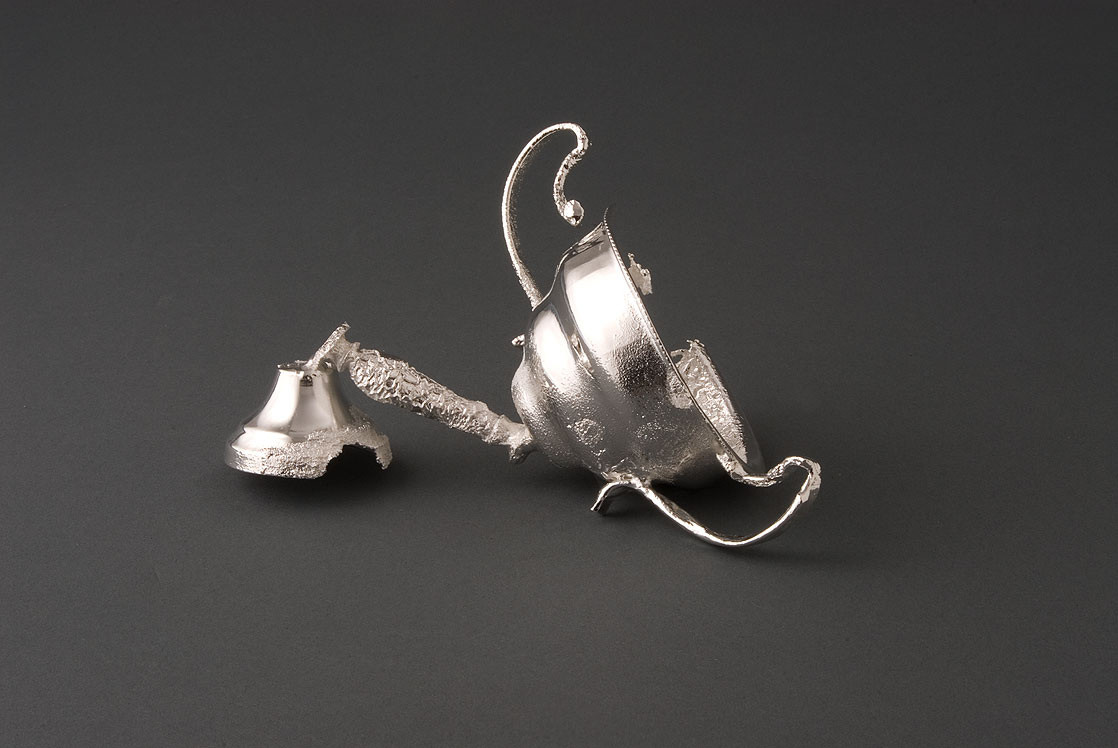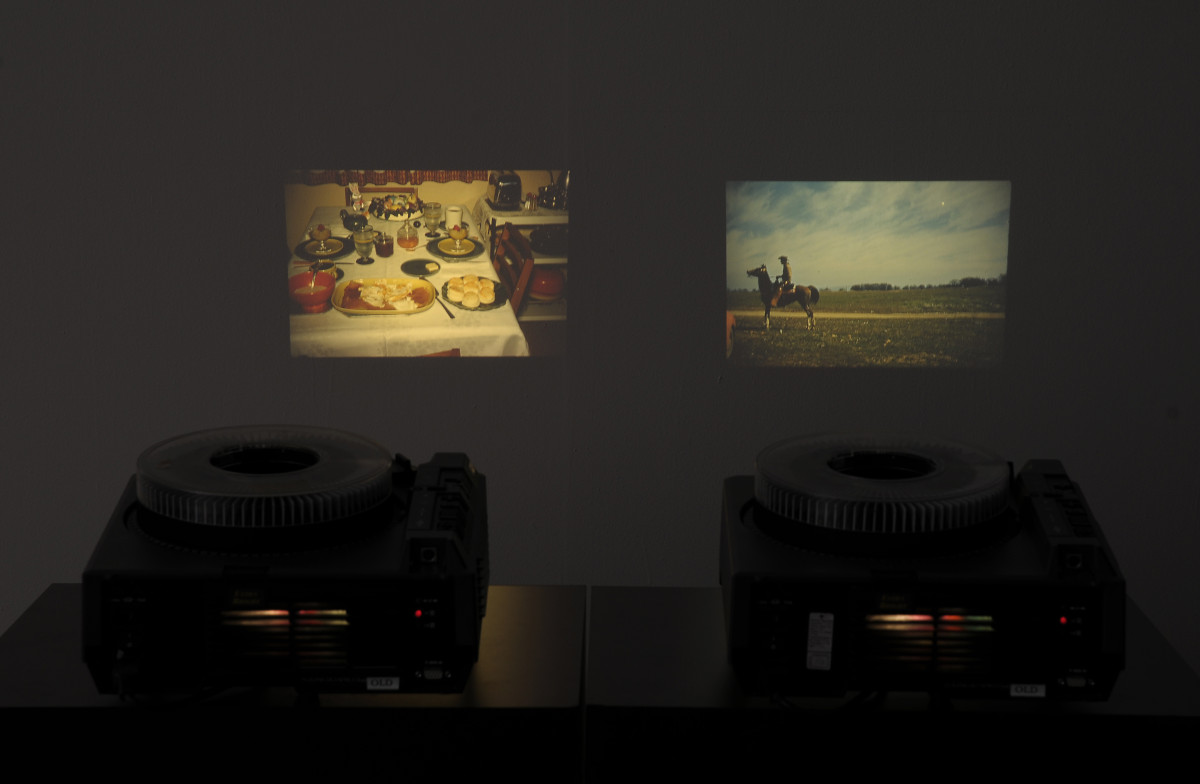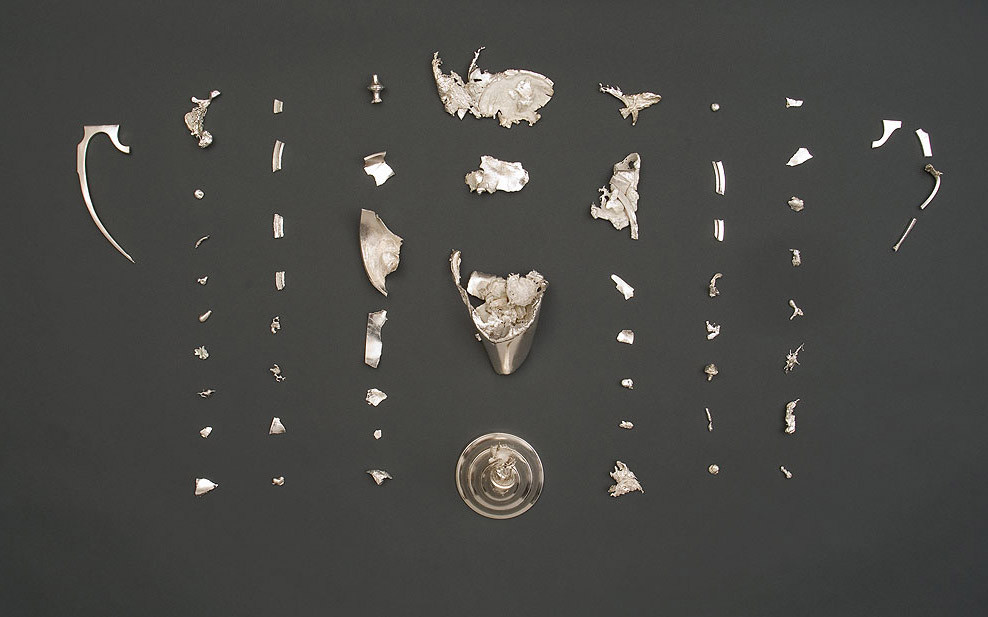 Elvis Richardson, The impossibility of losing in the mind of someone winning, 2007
Elvis Richardson, The impossibility of losing in the mind of someone winning, 2007Courtesy of the artist
Through the obsessive collecting of second-hand sport trophies, anonymous vintage family photographs and amateur home video footage as readymades for installation and video work, Elvis Richardson demonstrates how the detritus of everyday life acts as mnemonic devices as much as they are easily emptied of memory through their recontextualisation. Trawling through junkshops, garage sales, eBay and YouTube for source material, Richardson poetically questions how the meanings of objects invested with the connotations of domestic life are altered when severed from their original source. Left to collect dust on history’s scrap heap these totemic entities are bittersweet reminders of our mortality – beyond death, the things we own live on without us, indeed we cannot begin to imagine their afterlife.
Sporting trophies are signifiers of achievement, especially redolent with childhood nostalgia for days spent at school athletic and swimming carnivals where a trophy would be one of our first material understandings of how competition and achievement is signified. In fact, these generic mass-produced sculptures of triumph instil ideological meaning about how success and aspiration is measured. While competitive, goal-oriented power dynamics play themselves out in every facet of our personal and professional activities and relationships, it is in sport that these narratives of ambition to achieve are played out so literally. We spend much of our lives aspiring for success, muscling out competition where necessary, and rationalising setbacks to our lifelong trajectory of accomplishment. However long our lives might be, they are marked by a finish-line of death, beyond which the collected markers of our successes can and often do go astray. Richardson is a collector who rescues objects from the temporary death of the second-hand marketplace by indexing the amplified grandeur of these personalised moments and the shared cultural and social memories underscoring them.
As one of the 16 shortlisted artists in the inaugural Basil Sellers Art Prize, a $100,000 art prize themed around sport, Richardson was pitted against other mid-career artists – the art prize itself not unlike like a sporting arena where healthy competition cannot help but be informed by the politics of fashion, taste, industry or economics. Because surely there is no ‘level playing field’ in an art prize context where the diversity of works in terms of medium, materials and ideas makes it almost impossible to hedge bets on a winner. In a meritocracy, success comes according to specific criteria, however subjectively constructed. The criteria is surely contentious and blurred in the art world – loaded less by competing players than by the competing agendas of those who designate merit and award: like in sport, it is a survival of the fittest that makes you most deserving. The Basil Sellers Art Prize more than any other art prize in Australia, is doubly loaded with the dynamics of competition in that it looks to sport for its inspiration, but is set in the battleground of a contemporary art scene where success or failure is less predictable, where the rules of the game are less pronounced.
Richardson’s work for the Basil Sellers Art Prize critically engaged with the tactical game playing of sport as a means of understanding the broader implications of making artwork about competition for an art competition. The defeat of time embedded in old abandoned trophies – long detached from the auspicious event they once symbolised – is an apt metaphor for examining competition, aspiration and success in relation more to process than outcome. For Richardson, scaling the mountain is as much the victory as reaching the top. Mount Everest is inverted in Richardson’s Field (2008) revealing it to be flat on the bottom: sliced clean off the earth and flipped upside down to hover in weightless suspension like a lost meteoroid. This flat surface is used as a ‘level playing field’ for a cornucopia of found sporting trophies. The hierarchies prescribing the importance of some objects over others in the realm of museum vitrine display – as evident in The impossibility of winning in the mind of someone losing (2007) – is dismantled for the communal camaraderie of team spirit. The line-up of winners assembled for Field gleam with mute pride, shared success – they have climbed mountains, played the field, revelled in shared victories.
As much as she reclaims these trophies from the inertia of being unwanted, Richardson shows how identity is never really ‘levelled out’ entirely, no matter what the ideologies of team spirit or sportsmanship dictate. Because it is in triumph where a player is singled out for reward, in defeat where she or he feels the sting of shame or imagined ridicule. Unlike the anonymous mass of players comprising a sports team, indeed, like those frozen for eternity atop the bottom of Mount Everest in Field, players rise to the top, as much as they can sink to the bottom. Whatever the case may be, they are named and identified – detached from the faceless team, however momentarily.
The tensions animating the precarious tightrope between being identified or faceless, extraordinary or ordinary, a winner or loser, are evoked in Richardson’s video Credits (2008). Referencing a film’s scrolling credits that rarely command attention (a cue to leave the cinema or to stop and eject the DVD), Credits depicts the engraved name plaques on forgotten op-shop trophies as a literal honour roll or roll call. Eerily, the engraved plaques call to mind bronze grave markers, which resonate with the imperatives of death attached to relics of the past or disused items collected from the trash. The names scroll on an endless loop, attributing credit to those who triumphed for their team. But anonymity prevails because reading a name and their conquest tells you nothing much about the person, once at the top of their field; instead in Richardson’s hands they are transformed into a conceptual hagiography for a cast of faceless heroes whose triumphs are a legacy now lost.
In 2001 Richardson initiated Slide Show Land, an ongoing art project about other kinds of lost legacies. Comprised of more than 30,000 slides bought through eBay, Slide Show Land is Richardson’s rescue mission on the human ephemera of domestic photography otherwise destined for the scrap heap. By preserving these private histories in the public sphere, Richardson keeps long-forgotten families together long after their death through their insertion into the realm of contemporary art.
 Elvis Richardson, Slide Show Land, 2002
Elvis Richardson, Slide Show Land, 2002Install view at Monash Univeristy Museum of Art, Melbourne
Courtesy of the artist
Selections from these adopted slide collections have been presented in installation environments, as DVD slide shows and as editioned c-type photographs. In a gallery setting, the slide carousels are positioned on tables and projected simultaneously onto second hand screens at automatically timed intervals. Situated on each carousel is a tag indicating the geographic source of the collection and its eBay purchase value. Dealers from secondary markets rather than the photographers themselves list many of the slides on eBay because they often derive from deceased estates. This fuels Richardson’s adoptive desire to salvage these abandoned collections of vernacular photography from the dustbin of history and honour their origins by sequencing them in the order in which they were taken.
Slide Show Land speaks to our desire to peek into others’ personal lives – into backyards unique from our own. The ‘uniqueness’ of the work relates to the way the slides are derived from the photographic closets of strangers’ personal history and memory banks, but paradoxically there is a familiarity about these images in that they recall family dynamics, travel customs, and even (amateur) photographic conventions recognisable despite the anonymity of the subjects depicted. This familiarity and recognisability, due in large part to the nostalgia in which the slides are soaked, evokes for many the homespun slide show and memories of having staged such a slide show or, at worst, sat with barely concealed boredom as a family member or friend screened slide after slide of a recent travel adventure.
 Elvis Richardson, Slide Show Land: Dorothy and Jack, 2002
Elvis Richardson, Slide Show Land: Dorothy and Jack, 2002Courtesy of the artist
Richardson’s work reveals how personal histories become difficult to preserve, comprehend and maintain once the slide format becomes redundant. By performing a rescue mission on anonymous private histories that may have never again seen the light of day, Richardson demonstrates how it is not only certain media formats that face extinction, but personal history itself. When a house is burning, family photographs are the first thing rescued after people and pets. But the growing market for slides on second-hand markets like eBay illustrates how some media formats do not take kindly to posterity. Photographs may be passed down through generations of families, but slides seem to be treated as easily discarded anomalies. Slides, it seems, die along with their owners. Perhaps they become too onerous to view when the appropriate technology of the projector becomes scarce. A format deemed unviable for long-term preservation, the slide passes away, redundant as a technology, deleted from cultural memory. In Objects of the Dead (2008), Australian sociologist Margaret Gibson notes that photographs are not necessarily valued “just because they exist”:
We see evidence of this when family and personal photographs become part of the trading stock of antique and second-hand shops. Their value clearly changes – they are now objects of monetary exchange, objects for collections or one-off curiosities, because they document a period of fashion, a style of photography, a building site or streetscape that no longer exists.
Personal history, as a representation of memory and perception, is discarded once the media format used to depict that history is obsolete. But as with so many collectors who use eBay to build their collections of cultural minutiae, Richardson counters the process of redundancy written into things by foregrounding the rich archives of personal history and memory embedded in these objects. Like her sporting trophy installations, Slide Show Land preserves both personal history and the technologies used to memorialise them. Under the tutelage of their new owner, Richardson’s anonymous slides resist a fixed, singular or ‘unique’ interpretation. In a renewed environment they become subject to a viewer’s understandings of the cultural ritual of the familiar and familial slide show.
Richardson’s most recent works have engaged amateur home video clips uploaded to YouTube as evidence of another kind of domestic readymade ripe for re-contextualisation. “YouTube is the new eBay”, claims Richardson, and she delights in mining the site for confessional content at no fiscal cost. Unlike slides bought from eBay or trophies from op-shops, videos uploaded to YouTube engage anonymity differently; they are performed and uploaded by nobody’s aiming to become somebody’s through their consumption by a mass audience. Anonymity is ascribed both to the subject of these clips and to the audience numbers clocking in every time a video is viewed. It goes without saying that the viral nature of the web makes it the perfect place for instant fame if a YouTube video achieves popularity. That an anonymous audience of millions can have viewed a banal home video is part and parcel of the growing appetite for user generated online video content to document a passing parade of attention-seeking wannabies.
Downloaded video clips are reconstructed in Richardson’s Tomorrow (2008) and Funeral March (2008) in order to taxonomise particular kinds of phenomena found on YouTube. Tomorrow is a montage of clips showing young children unselfconsciously singing to camera the theme song from the musical Annie. It seems likely the parents of these performing children film and upload the footage in a bid to capitalise on the accelerating drive for celebrity and fame rendered ubiquitous and in-demand by reality television. More sobering in tone, Funeral March reconstructs Chopin’s Sonata 2 Opus 35 as played by various amateur musicians. Unlike slide photography, which elicits nostalgia for outmoded technologies and their representations of lives-and-times long passed, home video footage found on YouTube speaks to the here and now, to a perpetual present lived out online, rendered into a data-stream and disconnected from the materiality of, say, slide photography.
No matter how anonymous a collected object such as the trophy, slide transparency or online home video might be, its familiarity is owed in large part to the way things live on without us and are subject to renewal, reformatting, and re-collection. Elvis Richardson adopts the memories of others’ as devices for the perpetual reconfiguration of the representational machines by which those anonymous objects are imaged, in order to show how they can be imagined.
 Elvis Richardson, The impossibility of losing in the mind of someone winning, 2007
Elvis Richardson, The impossibility of losing in the mind of someone winning, 2007Courtesy of the artist
Essay for Eyeline
Published by Eyeline, issue 68 in 2009.